Product Catalog
.jpg)
Featured products
Products
Discover innovative products engineered for performance and reliability.
Product categories
Products
Explore our product categories designed to meet diverse project needs.
Wall Products
Polymer Nation offers durable, chemical-resistant wall coatings designed to deliver seamless, easy-to-clean finishes for industrial, commercial, and institutional environments.
Product category


Patching, Joint, Cove
Polymer Nation offers high-performance concrete repair solutions, including fast-curing rigid patches, durable joint fillers, and reliable cove applications for seamless, long-lasting results.
Product category


Urethanes
Explore Polymer Nation’s premium urethane topcoats, offering outstanding abrasion, chemical, and stain resistance with customizable finishes for resinous flooring systems.
Product category


Polyurea and Polyaspartics
Polymer Nation offers cutting-edge polyaspartic and polyurethane concrete flooring systems designed for chemical resistance, fast application, and long-lasting durability.
Product category


Epoxies
Explore Polymer Nation's premium 100% solids, self-leveling epoxy coatings, crafted for durability and aesthetic versatility across industrial, commercial, and residential flooring projects.
Product category


All products
Products
Browse our complete product lineup.
Miscellaneous Products
.png)
Miscellaneous Products
.png)
Polyurea and Polyaspartics
Urethane Concrete
Wall Products
Patching, Joint, Cove
Durable, low-odor urethane concrete for industrial cove bases. Offers high impact and thermal shock resistance with extended working time.
Miscellaneous Products
A 17 oz Colorant Packet for Water-based Materials & Urethane Concrete products




































































.jpg)





















.png)

